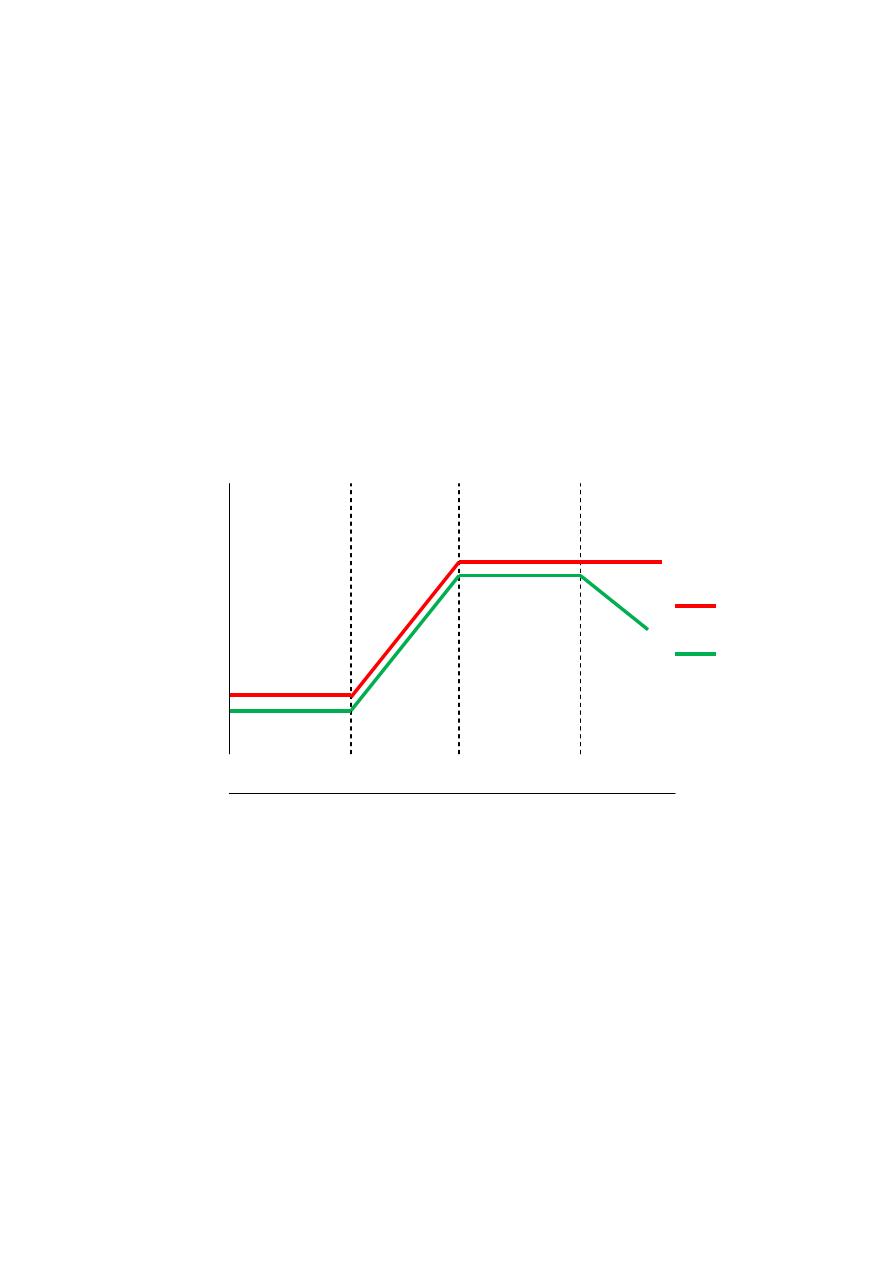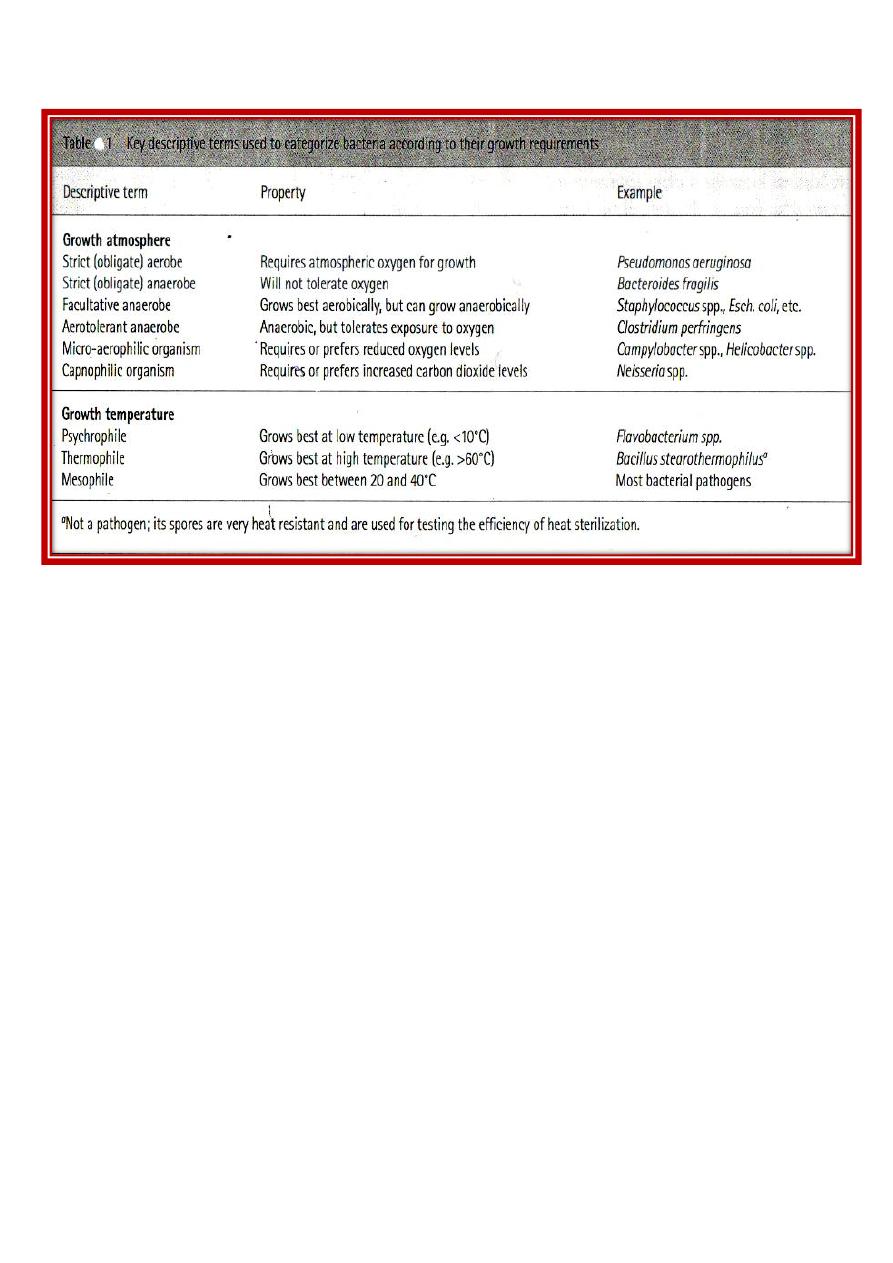
1
BACTERIAL
GROWTH , PHYSYOLOGY AND DEATH
Bacterial Growth
Bacterial
growth
involves both:-
(1)-an increase
in the
size organisms(when placed in a suitable nutritious environment and
physical and chemical conditions,a B.
cell beings
to grow)
(2)-an increase in the number of organisms(when it has manufactured approximately twice
the amount of component materials that it started with, it divides).
The bacteria between these two processes, is an increase in the total mass (biomass) of the
culture.
The range of suitable components for all known B. (and archaea) is so broad,defines as the
"global biosphere", includes the temperatures and pressures. Leprosy and syphilis have not
been able to grow or reproduce them in artificial media depends on molecular methods.
Growth in the laboratory has been used to serve many different purposed;-
1- For counting the number of bacteria which is important in the outcome of infections
2- For detection and identification of the bacteria.
3- For assessment of antibiotics effects.
4- For obtaining sufficient biomass for detailed biochemical analysis and to produce the
products of the brewing and biotechnology industries.
Type of growth
In the laboratory, B. growth can be seen in three forms;-
(1)-By the development of colonies on a solid medium.
(2)-By the transformation of a clear broth medium to a turbid suspension.
(3)-In biofilm formation,in which growth is spread thinly (300-400
μ
m in thick) over an
inert surface and nutrition obtained from a bathing fluid .
Single organism infections affecting normally sterile sites in the body, while in natural
microbial communities are complex of microorganism competing in many cases
cooperation . Pure growth of a single organisms in monocultures, to produce colonies
or high cell densities in broth, offer great practical advantages.

2
Growth phases in broth culture
If B. cells are suspended in a liquid medium, the increase in the cell number or mass can be
measured by:
(1)The total count (the no. of viable and dead cell) by microscope counting the cells in
volumetric chamber slide.
(2)The viable count (the no. of viable cells only) counting the number of colonies in a solid
surface media by electronic counters, defined as Colony-Forming Units (CFU)\unite volume.
(3) Measurement of turbidity which is proportional to the cell mass of culture in liquid
media.
The growth phases in broth pure culture are summarized in the growth curve shown in
(figure 1).
Figure (1) phases of growth in a broth culture
The lag phase:
When growth is initiated by inoculation of B. into broth media:
1-Number of cells(total count = viable count) remain constant during which cells
are thought to be preparing for growth, so this phase as the adaptation period of
microorganism to the new environment .
2-Increase in the size of the cell.
3-Increase in the metabolic rate .
4-Build up the necessary enzymes and intermediate metabolites for multiplication .
Lag phase
Exponential
or Log phase
Stationary
phase
Decline
phase
Time
Log cell number
Total cell
count.
Viable
Count.

3
Factors which effect on the duration of this phase:-
(1) Type of bacteria.
(2) Size of inoculums (no. of B. cells).
(3) Environmental conditions: like temperature (time of adaptation).
(4)Kind of media : better media shorter lag phase.
(5) Phase of culture from which inoculation is taken.
(6)Time required for synthesis of essential coenzymes or division factor.
(7)Time required for synthesis of new enzymes for metabolism.
The log phase (exponential phase )
Increase in the number of the cell then becomes detectable and established at the maximum
rate .This is known as the exponential phase because the no. of cells is increase exponentially
with time (B. reproduce by binary fission one→two, two→four, four→eight etc….).
Under favorable conditions growth and division are replaced every half hour or less (20
min) one cell reproduce thousands of millions of new organisms. Generation times (the time
require for B. to give two daughter cells) of pathogenesis organism in vivo are much longer
than in vitro.
The growth curve is normally displayed on a logarithmic scale , which shows a linear
increase in log cell no. with time .This log-linear relationship is constant for a given B. strain
under one set of conditions that it can be defined mathematically as the doubling time for that
organisms. Depending on the spp. ,the minimum doubling time can be as short as 20 min or as
long as several days (e.g . eight hours for E. coli,13 min for Vibiro cholerae and 24 hour for
Mycobacteria tuberculesis).So cholera is can kill within 12 hour whereas tuberculosis takes
months to develop , a result for diagnostic by culture is available for V. cholerae the next day
whereas several weeks for M. tuberculosis.
So in this phase :
1- Cells start dividing and their no. increase(total count=viable count) by constant rate.
2- B. have a high rate of metabolism.
3- B. develop best morphological with typical biochemical reaction.
4- B. are more sensitive to antibiotics.
Factors which effect on the duration of this phase :-
(1)Nature of B..
(2)Temperature of the environment.
(3)Rate of penetration of the medium depend on the concentration of the material in medium.

4
The stationary phase
Bacterial growth cannot be continued in a closed system with limited available nutrients,
so it slow down and the total count reaches a maximum and stabilizes .This shown as stationary
or
post-exponential phase .
So in this phase :
1-Growth slows and stops by limitation of nutrients in closed media , lack of biological space
and accumulation of inhibitory metabolites.
2- The total count= viable count . Most cell in this phase are not dead, so if they diluted into
fresh growth medium ,exponential growth will restart after a lag phase
3-Nutrients are depleted .
4-Toxic waste products accumulates .
5- The endogenous metabolism activity decreases .
6-Sporulation may occur at the end of the log phase and early stationary phase.
7-Cells may have high level of intracellular storage polymers such as glycogen and lipid which
absent in log phase.
8- G
+
B. become G- (physical and chemical variation) .
The decline phase
The total count of cells remains constant as in stationary phase, whereas the viable count
declines due to death of cells. Factors responsible for this are:-
(1)Nutritional exhaustion.
(2)Toxin products accumulation.
(3)Autolytic enzymes involution is common in this phase.
So the generation time of B. differ from 12 min→24 hour or more, and when most
organisms have died, few survive for several month or years ,this phase called survival phase.
Continues culture:-
The study of bacterial growth in broth medium provides a valuable point in practical ,
experimental and routine diagnostic procedures (e.g. the length of Lag phase and rates of
exponential growth in different states are used to make safety standards for storage in the food
industry) .
Cultures inoculated with cells prepared at different phase in the growth curve yield
different results , e.g. the exponential phase is used and can be extended in an open system
known as continues culture which used for both research and industrial purposes and is
obtained by:-

5
(1)-Chemo state:-
Chemo state studies have provides information on the chemistry of microbial growth
and the way in which different organisms convert specific substances into biomass.
In which cells of growing culture are harvested continuously by flows device into
collector vessel and nutrients replenished continuously which may pumped from the
medium vessel, here rate of growth is controlled by rate of addition of fresh nutrient. The rate
of production of new cells by multiplication = rate of removal of growth B. into collector vessel
and process may be continued . This process has made natural and genetically manipulated
microbes , a powerful resource for the biotechnology industry.
(2)-Turbido state:-
Addition of measured volume of fresh medium when turbidity in growth vessel reaches
predetermined value by photoelectric. As result of addition of fresh medium B. diluted until
reaching critical turbidity.
Surface growth
If a single B. cell is placed on a solid nutrient agar surface, it form a compact macroscopic
mass of cells, colony , each containing millions of cells.The characteristics of colonies (e.g.
color, shape, adherence, smell and surface texture)can be useful guides for identification of the
spp. of bacteria.
Some spp. do not form compact circular colonies but swarm over the agar surface, because
Itś capable of movement like Protus. Other spp. particularly Actinomycetes grow as long
filaments of cells (mycelial growth).
Such colony presents wide range of environments (from high concentration of oxygen
and nutrients at the edge of the colony to no oxygen or nutrients available to cell in the centre
of it).
Bacterial Physiology
A particular organisms has nutritional type and the physical conditions, reflect is
fundamental physiological characteristic, so placing an organisms into groups is an important
step in itś classification.
Hydrogen concentration
Some bacteria are:
(1) Acidophiles B. : for organisms, such as Lactobacillus spp., that grow at acid or lower ph
levels .
(2)-Basophilic B.: for organisms , such as Vibrio cholera, that grow at alkaline or higher ph
levels
(3)Neutrophiles B.: for most pathogens organisms that grow at neutral ph levels(ph=7.2-7.6).

6
Nutritional types
Three basic features are used in the presents terminology:
(1)The energy source: for ATP synthesis may be obtained from light in phototrophic
organisms . For chemical oxidations in chemotrophic organisms.
(2)The hydrogen donors:-if it requires organic source of hydrogen in organotroph organisms.
If it can use inorganic source (e.g. ammonia hydrogen sulphide) of hydrogen as in lithotroph
organisms.
(3)The carbon source:-if it can fix carbon dioxide directly as in autotroph organisms. If it
require an organic source as in heterotroph .
chemo-organotrophs (medically important organisms) and chemo-lithotrophs (e.g.
Pseudomonas spp.). Photo-lithotrophs with medical significance as the Cyanobacteria are
now produce many toxins that affect man.
Physical conditions required for growth
oxygen
All living organisms use oxidation to transfer energy to compounds that participate in their
internal biochemical and biophysical processes.
According to the biochemical mechanism used, bacterial metabolism can be categorized into
three types:-
(1)-Aerobic respiration (or simple respiration) is the metabolic process in which oxygen serves
as the final electron acceptor of the electron transport chain. Oxygen is reduced to water. This
respiration is used by all aerobic bacteria. Some oxidation-reduction reactions occurring in this
respiration result in the formation of the reactive superoxide (O
2
-
), hydroxyl (OH
-
) radicals
and hydrogen peroxide (H
2
O
2
) all of which are highly toxic.
So aerobic organisms or aerobes have developed three enzymes their functions:
a) Detoxify these molecules.
(1)
superoxide dismutase
converts O
2
-
radicals to hydrogen peroxide
(2O
2
-
+ 2H
+
H
2
O
2
+ O
2
).
(2)
catalase converts
H
2
O
2
to water and O
2
(2H
2
O
2
H
2
O + O
2
).
(3)
peroxidase
converts (OH
-
) to H
2
O + O
2
.
Lack of these E
s
(as in strict anaerobes) has the important of defining the atmosphere
necessary for growth and survival different organisms .
b) Provide protection for pathogenic organisms against the reactive O
2
intermediates produced
by phagocytic cells as a defence mechanism.
(2) Anaerobic respiration is the metabolic process in which inorganic compounds serve as
the final electron acceptors.Depending on spp.,acceptors can be molecules such as nitrate or
sulfate. Anaerobic respiration can be used as an alternative to aerobic respiration in some spp.
(facultative anaerobic organisms like Enterobacteriaceae) but is obligatory in other
spp.(obligate anaerobic organisms like Clostridium).

7
(3)Fermentation is an alternative process exhibited by some spp. as main mode of energy
metabolism,by which an organic metabolic is intermediate derived from a fermentable substrate
serves as the final electron acceptor. The substrates that can be fermented and the final products
depends on the spp. ,such as sugars.
In fermentation of glucose → lactic acid, the intermediate pyruvic acid is the final
electron acceptor.
glucose → ethanol, acetaldehyde (a derivative of pyruvic acid)is the final
electron acceptor.
Growth atmosphere
The major practical grouping of bacteria according to their atmospheric requirements
(table -1-):
(1)Strict or obligate aerobes require O
2
,usually at levels (≈ 20%) to grow and killed in
absence of it(e.g. Pseudomonas ,Bacillus ,Nitrobacter ,Sarcina , Mycobacterium).
(2)Strict or obligate anaerobes require the complete absence of O
2
and they killed in
presence of O
2
yield energy by fermentation (e.g. Clostridiam tetani, Bacteroides) grow well in
dead tissue and infected wound.
(3)Facultative anaerobes grow better in O
2
but are still able to grow well in itś
absence.(e.g.Vibrio, Escherichia, Salmonella, Shigella ,Proteus, Staphylococcus).
(4) Aerotolerant anaerobes have a fermentative pattern of metabolism (anaerobic) but can
tolerate (resist) the presence of O
2
because they possess superoxide dismutase (e.g. Clostridum
perfringens).
(5)Micro-aerophilic organism require a reduced O
2
level (=5%) (e.g.Campylobacter
,Helicobacter, Hemophilas).
(6) Capnophilic organisms the metabolic activates of the some organisms (e.g. Nerisseria ,
Brucella) are enhanced by presence of extra amount of Co
2
in atmospheric air,specially for first
isolation from the body (5-10%Co
2
)provided by oxidation and fermentation reaction.

8
Many medically important organisms are facultative anaerobic,because a mixture of aerobic
and anaerobic microenvironments in the human body, so strict anaerobes are associated with
infection of tissues where the blood supply has been interrupted.
In broth media, various atmosphere condition can also be obtained:
(1)Strict O
2
→ grow on the surface.
(2)Micro-aerophiles → just under the surface.
(3)Strict CO
2
→ in the body of the medium away from the surface.
Growth of CO
2
is improved by the addition of a reducing agent to medium as cysteine or
Thioglycollate .
Growth temperature
The major practical grouping of bacteria according to growth temperature in table 1 :
(1)Mesophiles: the most pathogen that can grow with in the temperature 20-40c
o
(e.g.
Pseudomonas 5-43c
o
,Neisseria 30-38c
o
).
(2)Psychrophile:organisms that can growth outside this range cold loving or at low
temperature ˂ 10c
o
(or -7,0-25c
o
)(e.g. Flavobacterium)these mostly soil and water bacteria
their important lies in their ability to grow and cause spoilage of refrigerated and frozen food or
pharmaceuticals stored at refrigeration temp(0-8c
o
).
Psychrophiles contain polyunsaturated fatty acid and Es act in reduced rate temperatures
they are unable to grow in body temperature, as in leprosy bacillus grow with skin and
superficial infections.

9
(3)Thermophiles: heat loving, can be a source of proteins with ˃ 55c
o
(e.g. Bacillus
stearothermophilus ). Remarkable thermotolerant properties such as Thermus aquaticus DNA
polymerase , the key E. used in the polymerase chain reaction (PCR method) . Organism that
grow in the colon (warmer than normal body temperature) can grow well up to 44c◦ .
These B. have saturated fatty acid to keep fluidity of membrane and it's function, and have
↑ GΞC content in their DNA to increase the melting point of DNA, to keep stabilizing of DNA.
So these organisms have specialized properties in their cell wall to tolerates the high
temperatures .
Theromphiles can be divided to : Facultative thermophiles = grow 20-40c◦ and
Strict thermophiles = grow above 40
0C .
Barophiles
Microorganismes isolated from the ocean floor may require
enormous
pressures before they can replicate , and this belong to the Archaea .
Nutritianal requirements
Minerals
These are Na , K , mangnesium , calcium , iron , zinc , copper , iodine and
strontium in traces .
Vitamins (As Accessory)
In general ,depends on nutrient requirement microorganisms divided in
to simple and complex.Vitamins the required amount differ widely in
various bacteria (e.g Neisseria gonorrhoeae needs glutathione ,
Corymebactenum diphtheria needs B- alanine, Staphylococcus aureas
needs nicotinic acid+thiamin, Haemophillus influenza needs hematin ).
All these are as growth factors which are organic compounds that B.
need and can't synthesize it , includes : purines and pyrimidinase for DNA
and RNA, amino acids for protein syuthesis. So vitamins as co-enzymes and
functional group of certain enzymes .

10
Humidity (Water)
Water activity affected by the presence of solutes such as , salts or
sugar dissolved in water
1- Halophiles= organism need or grow in high concentration of Nacl .
2- Halotolerant= organism grow in absence of Nacl .
3- Osmophiles= grow in high sugar concentration .
4- Xerophiles= grow in dry environment .
4/5 by weight of B. cell consist of water which is necessary for growth,
so drying in air injurious to many microbes . Different spp. vary in their
ability to survive when driend under natural conditions
(e.g. Neisseria gonorrhoeae, Treponema pallidum die quickly,while
Mycobacterium turberculosis , Staphylococcus aureas survive for weeks
or months).Bacterial spores survive drying (e.g. Bacillus anthracis)
survive for 60 years when dried on threads.
To preserve B. for long time , delicate organism frozen in a high
vaccum in a sealed glass ampoule , stored at dark room temprature ,this
method called Lyophilization(or freez drying).
Osmotic Pressure
Because of permeability of cytoplasmic membrane ,B. being
subjected to osmotic pressure and because of the strength of the cell wall ,
B. tolerants changes in osmotic pressure of their environment and grow in
media that contains salt , sugar and other solutes .
For most spp. maximum concentration of Nacl permiting growth 5-
20% (0.5% is added to all cultures make the culture isotonic). Halophilic
organism can grow in high concentration of Nacl up to saturation and this
will cause spoilage of food preserved by salt .

11
Exposure of B. to high concentration of salt 2-25% in solution cause
plasmolysis → shrinkage of protoplast.Its retraction from the cell wall
because of drawl of water and its done in G− than G+ .Transfer B. from
high concentration solution to dilution solution cause plasmoptysis →
swelling and bursting of the bacteria cell as a result of excessive osmotic
imbibitions of water.
Mechanical and sonic stress
The cell well of bacteria is rigid, vigorous shaking with glass beeds and exposure to
ultrasonic vibration cause repture of itś cell wall.
Influence of light and other radiation
Darkness provide a good condition for growth and viability. Direct light exposure shortens
the survival of bacteria like U.V. (ultraviolate rays, bactericidal), sunlight , mercury vapour
lamb radiation or ionizing radiation.
Bacteria Metabolism
Bacteria metabolism can be detected by biochemical tests in medical laboratories.
The cytoplasmic membrane of bacteria contains the components of the electron transport
chains and the proton gradient is generated across it (as they in mitochondria or across the
inner membrane of it in eukaryotic cell).
Bacteria can perform some energy requiring process at the cell surface as in flagellar
rotation (motility).
Bacteria metabolism has important for human as:-
(a)-indirect terms:-the resident microflora have important in human health and
disease.Examples:-
(1)-Bacteria in dental plaque produce acid which causes tooth decay.
(2) Bacteria in intestines deconjugate bile salts and contribute the entrohepatic circulation.
(3)-Role of bacteria in nitrogen excreted into colon in marginal human leading to the
formation of carcinogens.
(b)-Human beings are in directly affected by microbial metabolism.Examples:-
(1)-The original development of O
2
in atmosphere.
(2)-The availability of elemental sulphur.
(3)-The flow of nitrogen.
(4)-The ethanol and other alcohols and acids result from fermentation industry.
(5)-The bioremediation= to convert the deleterious effect of environment pollution.

12
Adaptive responses in bacteria:-
Specific sublethal but noxious stimuli (one stimuli) in environment effects on bacterial
gene expression leads to an adaptive stress response as heat shock raising to 45c
o
or a bove
for few minutes,this synthesis proteins called heat shock proteins to survive the bacteria in
heat shock involved initiating autoimmune damage and immune dysfunction.
So many of stimuli used are applied by human immune system to an invading pathogen ,as
acid stress in stomach and
hostile environment of phagolysosomes includes the oxidative and
Ph stress.
Global regulatory system or networks (more than one stimuli) with the bacteria that are
responsible for differential gene expression under different stresses or circumstances,as in heat
work ,cold shock, osmotic stress, nutrient limitation, anaerobic ….etc. to synthesizes only
these proteins appropriate to itś current circumstances ,examples:
(1)The virulence factors in bacteria which concerned with itś progress in an infection.
(2) Mesophile, acidophile, halophile M.O. adapted to these environment.
Bacteria defence against noxious chemicals:-
In clinical practice these are recognized as biochemical mechanisms of antibiotic
resistance and four basic categories are recognized:
(1)-Preventing access;-by low cell envelope permeability or efflux pumps affecting the
chemical concerned.
(2)-Destruction:-by enzymes that modify or degrade the chemical.
(3)-Lack of target:-many chemicals that damage bacteria work through specific targets, which
can be absent or be altered by mutation.
(4)-By pass of target:-an a alternate or modified pathway used.
Bacteria vability:-
Is the capacity of a cell to form a colony on an appropriate agar medium (CFU count),this
has been used in recognizing the cidal (lethal) and static (growth inhibitory) activities of
antibiotics.
Cidal→CFU count decline.
Static→CFU counts remain constant.
In suitable environment, the colony counts provide an accurate measure of viability,for
exception:-
(1)-Mycobacterium leprae ,Treponema pallidium,which can not be form colonies on agar
media , but its viable (uncultivated M.O.).
(2)-The phenomenon of bacteria recovery from injury (e.g. cold or osmotic shock)in which
colony counts can be shown to rise in the absence of cell division.
So ,some M.O. that are cultivable may be to switch to a physiological state in which can
not induced to form colonies, this called Viable But Non Culturable (VBNC) e.g.
(1)
in Vibro
cholera, which demonstrated by immunological properties not by the cultural properties.
(2)
in
tuberculosis disease can persist in VBNC that have latent phases.

13
Transition to VBNC state to result from an adaptive response might be the result of
programme of gene expression,as in spore formation,which that stationary and decline phases
in the growth cycle may represent the initiation of, and transition, to a non culturable phase
rather than loss of viability.
Measurement of vability has been of great value in:-
(1)-Action of antibiotics.
(2)-Action of disruptive influence as heat.
(3)-At different stages during experimental infections in animal models of human infections.
Bacteria Death:-
The CFU count remains the measurement of bacteria death .In stationary phase, depending
on the conditions and the M.O. concerned, the CFU counts
→being to decline→complete loss vability. or
→being to constant→not loss vability but lower CFU count.
The cumulative oxidative damage to cell proteins and other key macromolecules is one
critical determinant of survival.
Many bacteria carry genes encoding for programmed cell death. These system were first
identified as toxin-antitoxin pairs functioning to maintain particular genes in the bacteria cell
.Removal of all infective agents is necessary to achieve sterility (e.g. antibiotics,
decontaminating locations and materials , administration of therapy , safe practical
surgery , preparation of media, sampling material for bacteriological studies).
